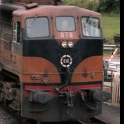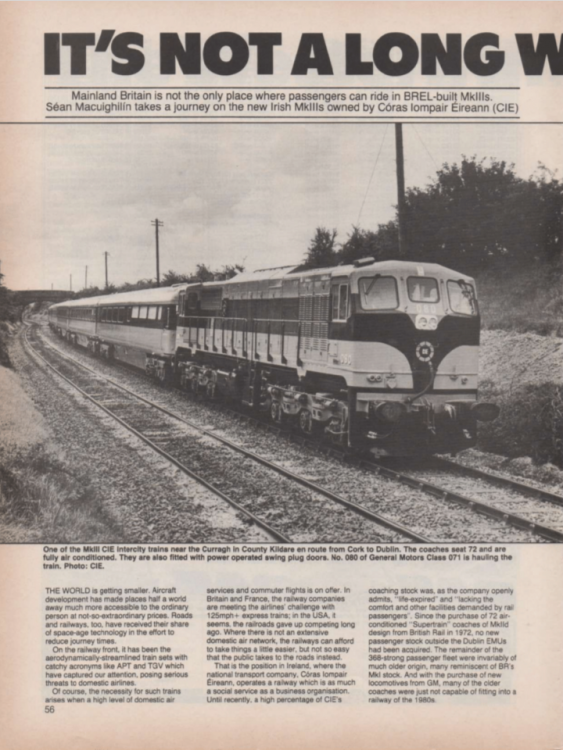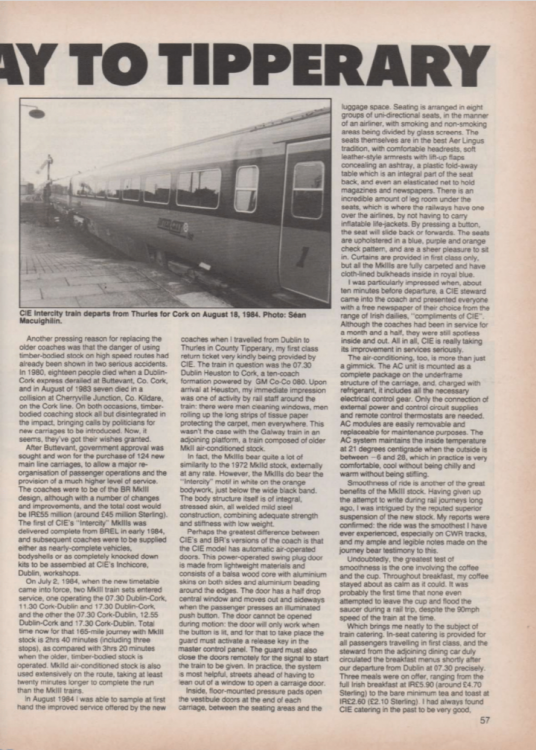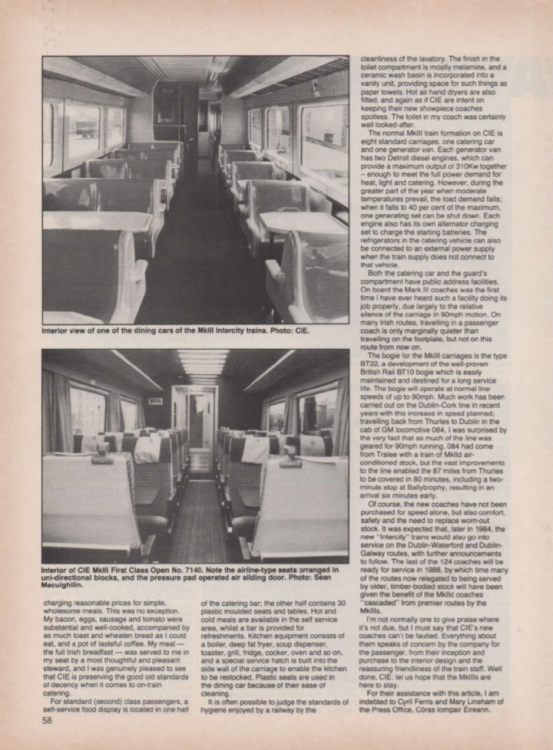-
Posts
420 -
Joined
-
Last visited
Content Type
Profiles
Forums
Events
Gallery
Blogs
Store
Community Map
Everything posted by hexagon789
-
I've often wondered why they had the "2"s given CIÉ wasn't operating a 3 class system, surely they didn't think passengers would mistake the interiors for First Class?
-
Now you've posted the correct date, I've no idea where I got my 1966 date from! Interesting month to choose September, given most major changes generally happen with new timetables which are typically April/May/June. Or in the case of First Class being rebranded Superstandard then new rolling stock.
-
Easily done! I've done that many times overlooking something because I've been expecting a particular version and the item in question has a variant/different type. I know what you mean about the "strings" but I'm not sure everything had "strings" I think there were alternatives. In that respect I'm not sure what to look for though.
-
Isn't that small wheel on the far right-hand bottom of the wagon a brake wheel?
-
I'm wondering if it might actually have been in Des Coakham's book on Irish carriages, because my only 1960s journal doesn't appear to mention the change but I've definitely seen it somewhere because I want to say something like the 4th April 1966 but I'm not at all certain on that date.
-
"A"s are Roots-blower, mechanically supercharged, 071s are turbocharged. With mechanical supercharging, the speed of the engine directly effects the supercharging, with turbocharging it is the load on the engine instead. This is taken from the article in IRRS Journal 074
-
Yes they did. The Cravens Superstandards, MkIId Superstandards and Composites all had a white "I" on the doors. Second Class became Standard in I think 1966, I did see a date somewhere in the Journals.
-
Thanks for that jhb, very interesting and insightful. I believe that at some point in the 1950s the Cú na Mara at least was a double railcar set (I think two 4-car splitting into Galway and Westport portions, so I wasn't sure if given the issues with 'A' Class reliability that situation was perpetuated into the 1960s. Thanks for your kind offer re timetables, a year or so ago I found a website with a small collection of 1910s-1930s Bradshaws scans including ones for Ireland in 1938. I forgot to bookmark the site and have been unable to locate it since, I don't suppose you have 1938 at all? I have a good selection of 1970s-1980s timetables but the other period which interests me is when steam was still king particularly the GSR B1a/800 Class post-war, so anything from when more normal service resumed in the early 1950s would be interesting as well to see what sort of timings services were getting, say 1951? I think things were relatively improved from the coal shortages by then. I think I mentioned once before reading a dissemination of the 1933 GSR timetable and at first being rather shocked by the journey times and paucity of service but then thinking how damn' lucky we are to have such frequent and fast trains (relatively speaking) on both sides of the Irish Sea nowadays compared to some years in the past.
-
Excellent and informative post as ever jhb. My one and only piece of Irish railway memorabilia from the 1960s, is a 1962 timetable. In it there are a handful of named trains (3 in all), given 1962 is pre-Cravens I wondered what sort of stock both motive power and carriages one should expect to see on the Sláinte, Fáilte and Cú na Mara of this period or were these all railcars? While I don't model this early, I still find it a fascinating period across Europe - so much change and innovation, arguably more so than any other single decade.
-
Yes, it is a publicity shot, it also features in the October 1984 IRRS Journal (I think, it might have been June) in the news section, it was a press run from before the coaches entered revenue service formed of EGV+4 Standards+Diner iirc. Only sets sets were in traffic at this point, and while the author writes that normal formation was to be EGV+Diner+8 Standards, the sets at this point were one eight-piece and one seven-piece both with "Firsts" in the formation. Indeed as can be seen in the article, the author's carriage was none other than the infamous "1st" 7140!
-
Thought this might be of interest, a short article written in August 1984 giving first impressions on the then almost brand-new CIÉ MkIII coaches:
-
Some digging produced the following, 1972 working timetable gives a 30mph linespeed on the branch. This photo from just before closure shows a 25mph restriction sign in the old style at the exit from Loughrea station.
-
Quite possibly, but would that have solved the power issue on the Enterprise? Given the 1,350hp Hunslets were felt to be rather underpowered for even six-coach loads singly. (Even accounting for the losses incurred by the HEP/ETH output of a Hunslet a 950hp 141 doesn't quite have the same grunt.)
-
What era? The older style were white rectangles with black figures, the more modern yellow hexagon with black figures date from about the 1960s and the older style lasted decades really only being replaced if speeds were upgraded/downgraded.
-
I seem to remember it took some political wrangling for NIR to get its 111s
-
I was more thinking in terms of engine power rather than bodyshell in the sense of having a Sulzer loco of over 2,000hp rather than a GM one.
-
Perhaps I'm wrong, but I thought that past Inchicore linespeed had been upgraded to 100mph for 50 miles continously as well as many other lower restrictions past Portlaoise having also been raised, such as the crossing at Emly going from 60 to 80 iirc. Though it's not done a huge amount for journey times. From 1987 the fastest weekday Dublin-Cork were 2h30 with two stops and linespeed was only 90 as far as Limerick Jcn., it was 75 to Mallow and only 65 beyond Mallow then. I believe the timing is mostly 2h30 with 4 stops now but that's with 100mph maximum and higher speeds permitted throughout the route now, so it's not really impressive. The morning ex-Cork non-stop is 2h45, but in 1999 the Sundays non-stop were 2h17 in the up and 2h18 in the down and there were only 3 short 100mph sections then, the longest 13.5 miles. I've often wondered that myself; then CIÉ might have ended up with something more akin to a Class 47 instead of the 071s.
-
59s are 60 or 75mph; 201s have a design speed of 165km/h (102.5mph). You'd be surprised how much difference aerodynamics make once you go above 70/80mph as Nigel Gresley was able to demonstrate with his design for the LNER A4 Pacifics in the 1930s. I believe that at over 80mph the saving was about 8.6lbs coal per mile.
-
Aerodynamics? The top part of the 201 cab being angled back whereas 59s are somewhat more slab-fronted.
-
Perhaps even with this for the advert That would be perfect to grace any late-1970s-1980s layout
-
If anyone is looking for a copy of IRRS Journal 061 (June 1973), there's a copy on eBay going for £3.50 (€3.90). This is the one which covers the "legendary" April 1973 Supertrain timetable in addition to articles on GSR coaching stock, CIÉ timetables from 1952-1972 and a colour photo insert of the AC stock exterior and interiors as well as the usual news section etc https://www.ebay.co.uk/itm/JOURNAL-OF-THE-IRISH-RAILWAY-RECORD-SOCIETY-JUNE-1973-No-61/313185358226?hash=item48eb4d5192:g:iCYAAOSwxElfOTV4
-
It was more scale than look with the platform, but the trains would definitely be totally out of place!
-
I wasn't sure if the 8100s were rheo only or regen & rheo. Load weighting is actually quite simple with air suspension, Mk3 coaches have a mechanical linkage which tops up the brake cylinders automatically up to 50% over the normal pressure for the carriage being unladen and I imagine the 8100s have a similar system rather than an electronic one being of the same era.
-
Very similar, just with rheostatic the braking energy is wasted as heat but with regenerative some of it is turned back into electrical energy which can be used by other trains. Recovery is about 25%, so you can make some decent savings on energy as well as brake pad or shoe wear. I believe some of the DART electric units are set-up for regen?
-
That I'm not sure about, is there a list of functions and does that state precisely what it is meant to simulate?
.png.c363cdf5c3fb7955cd92a55eb6dbbae0.png)






